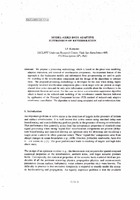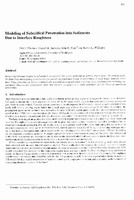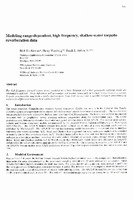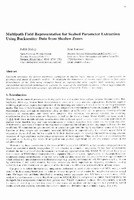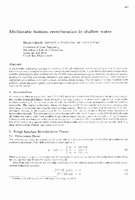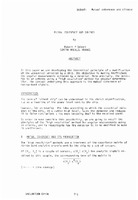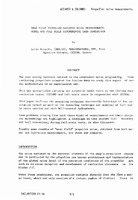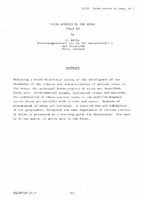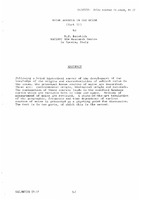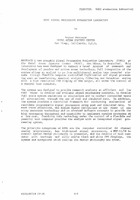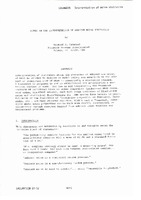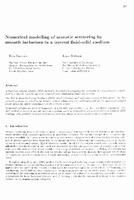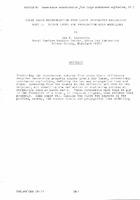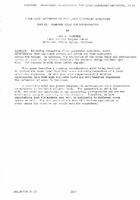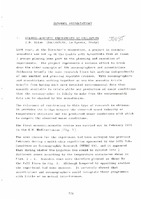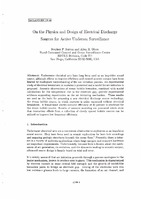Browsing Reprints by Type "Conference Proceedings (CP)"
Now showing items 161-180 of 290
-
Model-aided data adaptive suppression of reverberation
(NATO. SACLANTCEN, 1993/08)We propose a processing methodology which is based on the piece-wise modeling, adaptive estimation, and removal of reverberation components. An important feature of this approach is that backscatter models and information ... -
Modeling of subcritical penetration into sediments due to interface roughness
(NATO. SACLANTCEN, 1997)Recent experimental results reveal acoustic penetration into sandy sediments at grazing angles below the critical angle. We have been investigating a mechanism for subcritical penetration based on scattering at a rough ... -
Modeling range-dependent, high-frequency, shallow-water torpedo reverberation data
(NATO. SACLANTCEN, 1997)The high-frequency, forward bottom losses predicted by a lossy Rayleigh and a Biot poroelastic sediment model are substantially different. These differences will accumulate and become measurable in multiple bottom bounce ... -
Multipath field representation for seabed parameter extraction using backscatter data from shadow zones
(NATO. SACLANTCEN, 1997)Inversion strategies for bottom parameter estimation in shallow water impose stringent requirements on accuracy and speed of acoustic models. We highlight the importance of second order effects as first order determinants ... -
Multistatic bottom reverberation in shallow water
(NATO. SACLANTCEN, 1997)A wavenumber integration approach to modeling of the full multistatic reverberant field produced by small-scale bottom roughness in stratified shallow water waveguides has been developed. A perturbation approach to rough ... -
Mutual coherence and silence
(NATO. SACLANTCEN, 1985/01)In this paper we are developing the theoretical principle of a modification of the acoustical emission by a ship. Its objective is making inefficient the angular measurements achieved by a detector. More precisely, the ... -
Near field propeller radiated noise measurements: model and full scale experimental data comparison
(NATO. SACLANTCEN, 1985/01)The ever rising interest related to the underwater no1se originating from cavitating propellers prompted the Italian Navy to study this aspect of naval architecture in an experimental way. This was accomplished carrying ... -
Noise sources in the ocean - part 1
(NATO. SACLANTCEN, 1975/10)Following a brief historical survey of the development of our knowledge of the origins and characteristics of ambient noise in the ocean, the principal known sources of noise are described. These are: environmental origin, ... -
Noise sources in the ocean - part 2
(NATO. SACLANTCEN, 1975/10)Following a brief historical survey of the development of our knowledge of the origins and characteristics of ambient noise in the ocean, the principal known sources of noise are described. These are: environmental origin, ... -
NOSC signal processing evaluation laboratory
(NATO. SACLANTCEN, 1979/12)A new acoustic Signal Processing Evaluation Laboratory (SPEL) at the Naval Ocean Systems Center (NOSC), San Diego, is described. This laboratory has been designed to support a broad program of research and development of ... -
Notes on the interpretation of ambient noise statistics
(NATO. SACLANTCEN, 1982/06)Interpretation of statements about the character of ambient sea noise, as well as schemes to measure or model noise, are sensitive to the context or underlying view of what is essentially a stochastic process. A framework ... -
Numerical modelling of acoustic scattering by smooth inclusions in a layered fluid-solid medium
(NATO. SACLANTCEN, 1997)A boundary integral equation (BIE) method as descnbed for computing the scattering of a monofrequent acoustic field by a smooth, rigid 30 object in a layered range-independent fluid-solid medium. The BIE is discretized ... -
Obtaining the ocean index of refraction spectrum from the acoustic amplitude fluctuations
(NATO. SACLANTCEN, 1997)The feasibility of using acoustic measurements to determine the properties of a shallow water internal wave field is investigated through numerical simulations. The random intemal wave field is modeled by a generalized ... -
Ocean-basin reverberation from large underwater explosions: part 1: source-level and propagation-loss modelling
(NATO. SACLANTCEN, 1975/10)Predicting the reverberant returns from ocean basin reflectors requires describing acoustic source levels for large, conventional underwater explosions, defining the two way propagation loss and signal spreading from the ... -
Ocean-basin reverberation from large underwater explosions: part 2: computer model for reverberation
(NATO. SACLANTCEN, 1975/10)Following detonation of an underwater explosion, sound reverberates from the ocean surface and bottom and from scatterers within the medium. In addition, the boundaries of the ocean basin and obstructions within it, such ... -
Ocean-bottom reflectivity (a point of view)
(NATO. SACLANTCEN, 1975/10)The analysis procedures for extracting bottom loss values from pulsed acoustic signals that have interacted with the ocean bottom do not inherently consider sub-bottom refraction and reflection of sound, which are important ... -
Oceanic layered microstructure and fronts
(NATO. SACLANTCEN, 1971/12)This talk is divided into two parts: one deals with oceanic microstructure, with particular attention to the so-called "layered microstructure"; the other part is concerned with oceanic fronts. As an example of the latter ... -
Oceanic-acoustic experiments at SACLANTCEN
(NATO. SACLANTCEN, 1971/12)Last year, at the Director's suggestion, a project in oceanicacoustics was set up at the Centre with scientists from at least 3 groups playing some part in the planning and execution of experiments. The p roject represents ... -
On the physics and design of electrical discharge sources for active undersea surveillance
(NATO. SACLANTCEN, 1993/08)Underwater electrical arcs have long been used as an impulsive sound source, although efforts to improve efficiency and control acoustic output have been limited by inadequate understanding of the arc initiation process. ... -
Optimal detection and tracking of acoustical noise sources in a time-varying environment
(NATO. SACLANTCEN, 1982/06)A dynamical detector estimator is derived for nonlinear nongaussian signal processes based on Bucy's representation theorem which is the fundamental result in stochastic filtering. A quantized version of two-dimensional ...
